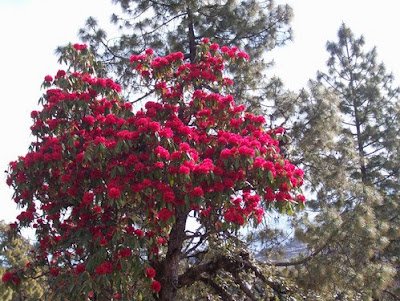Bal Mithai is a brown chocolate-like fudge, made with roasted khoya, coated with white sugar balls, and is a popular sweet from the Himalayan state of Uttarakhand in India, especially regions around Almora. The Khim Singh Mohan Singh Rautela shop in Almora is famous in the whole uttarakhand for their distinct Bal mithai and Singhauri.
History बाल मिठाई
Over the years, the sweet has found home in many Kumaoni stories and folklore, arising from the milieu of Kumaon, as evident from the memoirs of noted Hindi writer, Shivani, wherein she reminiscences, the Almora Bazaar, and the lane filled with smells of locally made sweets, and the shop of Jogalal Shah Halwai , who is said to have invented the sweet, made with milk from nearby Phalsima village, and then wrapped in sugar dipped posta or Khas khas (Opium poppy) seeds. Although it is unknown whether it is ancient. Over the years, rapid commercialization, and cost cutting moves lead to local shopkeeper replacing the original khas khas sugar balls, with plain sugar balls, that look like homeopathic pills. Even a recent version is completely devoid of sugar balls, to suit changing urban and tourist tastes. After, Joga Shah Halwai, Rautela brothers - Khem Singh and Mohan Singh made a name for themselves in sweet preparations

Recipe of बाल मिठाई
Baal Mithai is made by cooking khoya (evaporated milk cream) with cane sugar, until it becomes dark brown in color, colloquially called "chocolate" for its color resemblance. This is allowed to settle and cool, and cut into cubes which are then garnished with small white sugar ball.
History बाल मिठाई
Over the years, the sweet has found home in many Kumaoni stories and folklore, arising from the milieu of Kumaon, as evident from the memoirs of noted Hindi writer, Shivani, wherein she reminiscences, the Almora Bazaar, and the lane filled with smells of locally made sweets, and the shop of Jogalal Shah Halwai , who is said to have invented the sweet, made with milk from nearby Phalsima village, and then wrapped in sugar dipped posta or Khas khas (Opium poppy) seeds. Although it is unknown whether it is ancient. Over the years, rapid commercialization, and cost cutting moves lead to local shopkeeper replacing the original khas khas sugar balls, with plain sugar balls, that look like homeopathic pills. Even a recent version is completely devoid of sugar balls, to suit changing urban and tourist tastes. After, Joga Shah Halwai, Rautela brothers - Khem Singh and Mohan Singh made a name for themselves in sweet preparations

Recipe of बाल मिठाई
Baal Mithai is made by cooking khoya (evaporated milk cream) with cane sugar, until it becomes dark brown in color, colloquially called "chocolate" for its color resemblance. This is allowed to settle and cool, and cut into cubes which are then garnished with small white sugar ball.
Wikipedia.org







